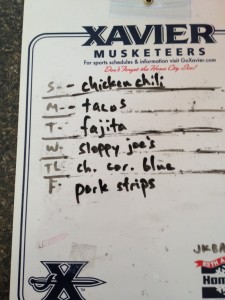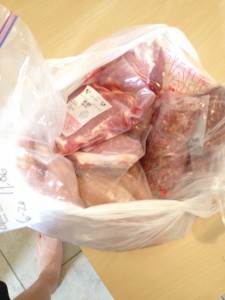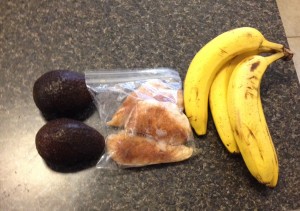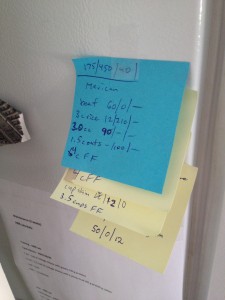I hate articles that start with quotes. So I’m writing these two sentences before I…………
“By failing to prepare, you are preparing to fail.” – Benjamin Franklin.
This sentence is plastered on 97% of all classrooms in America. It’s cheesy, it’s stupid, it’s probably motivated about 3 children out of a zillion who have stared at the quote during a less-than-interesting lecture.
However cheesy it may be, it rings true.
When a 13-year old boy comes into my classroom, and his papers, backpack, and personal appearance resemble Pigpen from Peanuts, I’ll often tell him to “get organized”.
And I say it with a grimace. Because I know the error in my ways. Telling someone to “get organized” does nothing for most people.
Organization is a skill. It’s a learned habit. It’s something that doesn’t come natural for many.
When I was in college, changing my bedsheets was an afterthought. Clean laundry was a luxury. Everything got the “sniff-test”. I had one towel for use after showering. I don’t think I washed it once in five years. Rationale? “I’m clean when I use it. Why wash it?”
But then, the craziest, most insane thing happened………….I got a girlfriend.
And I knew it was pretty serious. I knew if I played my cards right, she might stick around a bit………..
But she took one look at my disgusting habits and my germ-infested habitat (my own Mother, when visiting, once walked to the corner GAS STATION, of all places, because she wouldn’t sit on my toilet), and promptly stated:
“You’ve got some serious work to do if you think the two of us will ever live together.”
So, I figured it out. At first, it was a bit challenging. (What temperature setting do you use for underwear?) And this was before the days of smart phones. I had Moms on the speed dial, for sure.
But it got easier over time.
And now? That girlfriend? The mother of my kids. My wife of 9 years this July. And she’ll openly tell you that now, SHE’S the messy one.
It’s funny how quickly your skill level can change with just a bit of application.
You can read every post on this site, but if you’re not sure how to organize the protocols, you’re gonna have a hell of a time with your execution.
Hitting your macronutrient numbers is the biggest indicator of future success. Hit ’em, get awesome results. If you don’t? Well…………..
But it’s not as easy as you might think.
If you’re used to hitting up a sub shop every day for lunch, it’s a relatively drastic switch to begin to pack a nutritious lunch every day.
And if every single night, you’re cooking for an hour plus just so you can eat your lunch the following day………………..that’s not efficient.
Sustainability is king. Everything we do needs to be sustainable, if we are going to do it for a substantial time period. It can’t take too much time, too much energy, too much effort, or too much of anything, really.
So, it’s time to discuss and learn the art of “meal prepping”.
“Meal prepping” is taking a few hours when you have some free time, and, well………prepping your meals. Cooking the parts that can be cooked early, chopping veggies, planning your week, etc. It’s done for two main reasons:
1. It’s a time saver in the long run.
Eating well doesn’t mean you have to be Emeril-freaking-Lagasse. Most meals can be made in under 20 minutes. But it will help if your veggies are already chopped and your plan is in place.
This is especially true for lunches. Nobody wants to make their lunch every morning (or previous night) for the whole week. Then you have an annoying, little, daily chore to do when you’d rather be watching Game of Thrones.
2. If you have a plan in place, you’re more likely to follow it.
If you know exactly what you’re going to be eating, you’re extremely likely to eat it. If you don’t, you’re extremely likely to call Pizza Hut when you get home from a long day at work. Hitting macros? It goes out the window. Quick, fast, and in a hurry.
A few thoughts and ideas about meal prepping before we get started:
A. This guide is made with the assumption you are cooking for one.
Cooking for two? Double your recipes. Eat half.
Cooking for a family? Triple your recipes. You get a third, your partner gets a third, your kids get a third. Quadruple the recipe if your family is Catholic.
You don’t have to have an 8-burner stove to hit macros effectively. Just estimate your amounts and call it a day.
B. Meal prepping is best done on a completely “off” day.
No work and no training.
If you have a normal schedule, it’s best done on a Saturday or Sunday, depending on when you have time.
If you have a varied work schedule, you may have to find your off day on the calendar, and schedule your meal prep day accordingly.
But a meal prep day should set you up for however many consecutive work days there are until your next available day to prep.
C. Have fun with it.
Throw on some music. Turn on the baseball game. Involve your family if you can.
It can be lots of fun – if you want it to be………..or vice versa.
So, here it is.
Your guide to meal prepping.
YOUR STEP-BY-STEP GUIDE TO EFFECTIVE MEAL PREPPING
1. Grab a writing utensil and some paper – create your grocery list as you plan.
Use your phone if you wish. But you’re gonna need a list. No walking into Kroger unprepared.
That’s what causes you to buy white-chocolate covered Oreos.
We’ll have none of that.
Unless they fit your macros……..
2. Decide on your lunch menu – and add the appropriate items to the list. Keep lunches as easy and simple as possible.
You have your lunch macros. Create a meal to hit them.
As you figure out what you’ll need to create that meal, put the items on the list.
The second part – keep lunches simple and easy – is very important.
Lunch needs to be seen as a way to get some food in your belly and keep you going throughout the day.
Lunch, for many, is an event. It’s a reason to get out of the office. It’s a daily calorie bomb.
If you want to ensure long-term success, you’ll need to make your own lunch more often than not.
And if your lunch is Peking duck with caramelized onions and a rosemary herb sauce…….yeah……..you’re not gonna make that every night.
You’d be amazed what you can do with a simple chicken breast.
Training day? Eat it sliced up on a wrap with veggies.
Rest day? Eat it with an avocado and a few slices of cheese.
There’s your whole week. Done. 5 chicken breasts and a few extras.
Perhaps your preferences differ, but the logic is the same: Make your lunch easy and you will prosper in the long term.
3. Decide on your dinner menu – and add the appropriate items to the list. Be sure to plan around your schedule. Post your dinner menu in your kitchen.
Go buy a magnetic, dry-erase board. Or an actual calendar. Under each day, figure out your schedule and decide on a meal.
Make sure you plan around your week.
Have a night where you’re working late? Probably not the best idea to make barbecue spare ribs that require four hours in a smoker.
Your skillet is your best friend. So many meals can be made quickly and easily with just a skillet.
Tacos, fajitas, chicken stir fry, sloppy joes, bacon & eggs, omelettes, etc. Hell, even steaks and burgers can be made on a skillet.
Each of the above meals, with a touch of practice, can be made in around 15 minutes. Less with a bit of prep work on the veggies/extras.
But sit down and figure out what you’re going to eat each night. And write it down. Put the items you’ll need to purchase on your list. And after you figure out your week’s worth of meals, slap it on your fridge.
That way, when you get home on Tuesday, you won’t say, “Macros? I ain’t got time for that.”
You’ll look and say, “Bacon and eggs? Awesome. Let’s do this.”
Our dry erase board with our dinners.
On Saturdays, we dine out.
It’s a bit weird to know exactly what you’re gonna eat.
But with preparation comes proper results.
4. Grocery shop with your complete list. Only buy the items on your list.
If it’s not in your house, you can’t eat it. Right?
5. Do all of your weighing and measuring once you get home from the store.
Beef is generally easy. It’s often purchased in one-pound packages.
A bit of simple math will tell you the exact macros in your beef.
Take the total macros for the full pound. A serving size is generally four ounces. So, a pound would be four servings.
Assuming this is the case, multiply your protein and fat numbers by four. This is the total amount of protein and fat in the entire one-pound package.
Want half of those numbers? Take half. Want a third? Take a third. There’s really no weighing necessary.
Chicken and pork are different stories. They often don’t have macro information on the package. Especially the chicken.
A solid recommendation, if you don’t have a scale, is to shop with packaging and fractions in mind.
For lean meat, the simplification 1 pound = 100 grams of protein works quite well.
Buying chicken? Look for a package with 3 chicken breasts that weighs ~1.5 pounds. You can assume each breast is ~0.5 pounds. Half a pound would be 50 grams using our simplification.
If that sort of “loose counting” will set off your OCD, then grab your scale and have at it. To each their own.
But put each meat portion in its own baggie. That way, when Tuesday rolls around and you need to cook your meat, there’s no weighing or counting involved. Grab your bag and throw it on the skillet.
Our meat bag.
Chicken, beef, and pork.
Not much to see here.
It’s just a bag of meat.
6. Prep/cook/chop any lunch items that will need “kitchen time”. Store them in your fridge. For best results, make lunches that are ready to go with no additional work necessary.
As stated back on number 2, make your lunches simple.
The chicken recommendations work for us – you surely will have your own preferences.
Some people make a bit extra at dinner and take the leftovers each day for their lunch at work.
Lunchmeat can be your best friend – but it can also get very pricey. $8-$12 per pound sometimes.
Chicken breast can often be purchased for around $2 per pound – a massive savings.
If purchasing chicken for your lunches, throw them in a baking dish, season as preferred, and put them in your oven.
Once cooked, allow to cool and put in a Tupperware container or a plastic sandwich bag.
If you’re gonna need some chopped veggies or additional items, prep them. Have them ready to go.
You want to be able to open up your fridge, grab your lunch, and go. With no additional time and/or energy wasted.
Our weekly chicken for lunches.
Mine with cajun seasoning.
My wife’s without.
My whole week’s lunches.
Training days: eat the chicken with two bananas.
Rest days: eat the chicken with an avocado.
Simple, tasty, and easy.
7a. Each evening, take out a Post-It note and figure out any “extras” you will need to hit your macros for the following day. Stick your Post-It on your fridge.
This way, you will know EXACTLY what you will be eating the following day.
Lunch is taken care of, and dinner is planned.
If your dinner hits those macros fully, then it’s all you need.
But if you’re gonna be a bit short of a particular macro, and you need to fill in the gaps, find out what you’ll need for dinner the following day, and write it down on a Post-It.
Stick the Post-It to the fridge.
And do this the night before. That way, there’s no thinking, no second guessing, no “Hmmmm, maybe I should eat a gallon of ice cream……….”
You have a plan on your fridge and you’re good to go.
My plan for the following day.
Keep in mind I’m bulking when
you look at the macro numbers.
7b. Save your Post-It notes. Did you enjoy that dinner? Awesome. Next time you don’t have to plan.
Over time, this is a huge help.
As long as your macro numbers stay the same, you can keep that note right there on the fridge.
Next time? You’re good. No planning necessary.
If you change your macros, make an adjustment to the Post-It. And you’re still good to go.
8. Take your lunch to work, eat it, train (or not), come home, grab your Post-It, and execute your plan.
You’ve just taken the guesswork out of everything.
You have a lunch in your hand, and a plan for your dinner.
Your dinner items are available and ready, and will take a minimal amount of effort and time to create.
Your menu is posted; you (and everyone else in your family) knows exactly what’s for dinner.
All you have to do now is follow through and execute.
And smile when you look at yourself in the mirror.
On the weekends, you can surely deviate from this type of rigid structure. Make yourself some bacon and eggs. Take some more time with recipes. Use the grill. Get out the smoker.
Whatever the case may be.
But for the week, if you don’t prepare for the grind, the grind will get ‘ya.
You’re gonna be pulled in a hundred different directions between work, husband/wife, kids, training, extra-curriculars, etc.
Having a plan in place frees your mind of the burden of proper macro counting.
It’s done before you even begin your day. One less thing.
I hope you’ve found this post useful.
You will certainly need to tweak to fit your own family’s schedule and eating habits.
If you have any questions, tips, or suggestions, leave them in the comment box – they’re always welcome.
Happy prepping!
-Jason





